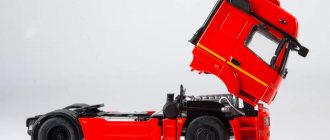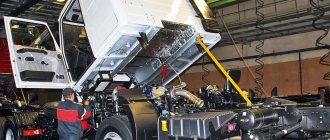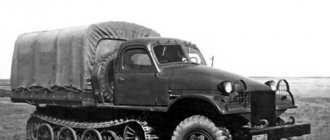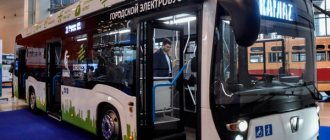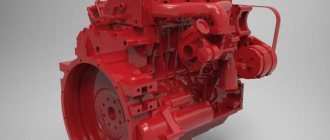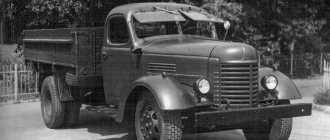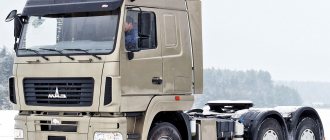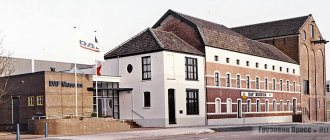Production and release of engines at the KAMAZ plant
The production and release of new KAMAZ 740 engines and Euro models is carried out today at a tremendous pace, because diesel engines of the Kama giant are in great demand.
The engine manufacturing plant of PJSC KAMAZ in Naberezhnye Chelny is celebrating the fortieth anniversary of the appearance of the first KAMAZ engine.
Russian engine building was brought to a new level of development on December 4, 1975. As the head of the fittings and assembly shop noted, it was the KAMAZ 740 engine that revolutionized the automotive industry in the USSR. The transition of the country's automobile fleet from gasoline to diesel units simplified the service process and brought savings and reliability to the operation of vehicles. The release of diesel engines radically changed the future of the automotive industry.
The first KAMAZ 740.10 engines were assembled by hand. All parts and components were moved around the workshop without the use of modern technologies. Only after a while the first automated tape was launched. The next stage in the life of the plant was the production of KAMAZ engines of Euro-1 environmental class. This happened twenty years after the release of the first model. The development of the KAMAZ Euro-1 engine took place at a difficult time for the plant. A major fire occurred, and in addition to the funds needed for the creation and production of the KAMAZ Euro-1 engine and the KAMAZ Euro-2 engine, it was necessary to find finances to restore the enterprise. By the end of the 90s, KAMAZ PJSC managed to reach the level of a competitive, successfully developing manufacturer.
The plant entered the twenty-first century with a new, improved engine. Thanks to the launch of mass production, engines for KAMAZ EURO-2 class vehicles began to arrive across the country in unlimited quantities. The company did not stop there, and already at that moment the test sites were getting acquainted with a new branch of design achievements - engines that meet Euro-3 standards. To produce new engine models, divisions were opened to produce basic aluminum and cast iron parts, as well as components for vehicle systems consisting of these alloys.
KAMAZ Euro-4 engines appeared in 2008, and reliably perform their functions on vehicles transporting goods and passengers. The power of these units reaches 450 hp, they are reliable in operation and economical. They are distinguished from the Euro-3 engine by the presence of a new Common Rail fuel supply system. Along with KAMAZ diesel engines, the company launched the production of gas-powered engines. The plant is currently working on introducing new changes. A new project is being considered, in which it is planned to launch the production of new transfer cases. The first samples have already been manufactured in November and are being tested.
The “Bridges” project is in the future. Turning and milling equipment has already been delivered and assembled to the enterprise. It will process parts from Pittler and Klingelnberg companies. The staff is already undergoing training and adjustment work is underway. It is planned to begin production of a completely new unit in 2022. Work on the new KAMAZ engine is progressing according to plan,” said plant director Sergei Snarsky. Work has been carried out to search for suppliers, and the amount of equipment required to produce a new engine has been determined (30-40 items). The project is currently at the stage of selecting a supplier. According to the project, it is planned to launch production of engines with a capacity of 350 - 700 hp. The KAMAZ engine will have a design that meets Euro-6 standards and will be able to successfully compete in the global market.
Russian Cummins: engine production in Naberezhnye Chelny
We have already written that in Naberezhnye Chelny, the Russian-American joint venture Cummins KAMA launched a new assembly line for Cummins L series engines. However, then most of the article was devoted to trucks on which Cummins engines are installed. It’s time to talk in detail about the production itself
Sergey Zhukov
Let's start with the fact that the Cummins KAMA production program traditionally includes two families of engines. The lion's share - about 80% - is made up of Cummins ISBe6.7 inline sixes with power from 205 to 300 hp. With. These units are successfully used on medium and heavy KAMAZ trucks (95% of all shipments), as well as on NefAZ and KAVZ buses, MAZ trucks, Eksmash, Promtractor special equipment and others. The rest of the output is made up of Cummins ISBe4.5 diesel fours, available in a power range from 140 to 207 hp. With. Moreover, both families of engines are offered in versions of both the fourth and fifth environmental classes. The joint venture is also successfully developing the production of promising industrial modifications of its products to meet the needs of leading Russian manufacturers of road construction, industrial and agricultural equipment. For example, engines of the QSB6.7 Tier 3 series are built on a single platform with ISBe6.7, widely used in automotive technology.
Starting in March 2022, the Cummins KAMA JV systematically began expanding its product line by launching the assembly of L-series engines with a displacement of 8.9 liters and power from 280 to 400 hp. With. This step is due to the need for engines with power over 300 hp. in the KAMAZ production program. 9-liter engines are planned for installation on KAMAZ, RIAT, MAZ trucks.
Showing interest in such engines from manufacturers of agricultural and road-building equipment pushed engine builders to expand the applicability of these power units, as key customers appeared from the agricultural sector - Rosselmash, Claas, Gomselmash, MTZ.
Just a few words about the ISLe series. It combines the advantages of a lightweight and compact motor with the structural strength of heavy engines, providing high technical performance while meeting high environmental requirements. Weighing just over 700 kg, the engine is well suited for use in trucks and medium-sized tractors operating in Russian conditions, and provides the maximum level of torque for engines of this size. Industrial versions of the L series will be versions with mechanical and electronic fuel injection control systems for different certification levels.
PRODUCTION
All engine production, by the way, located on the territory, is concentrated in two places. Thus, the line for machining cylinder blocks is located in one of the buildings, while the final assembly of engines is located in the other. First of all, this is due to various technological requirements for the production premises in which the work is carried out.
Cummins ISLe Series Diesel Engine
Take, for example, the technology for processing cylinder block castings. The casting itself is imported from abroad (exactly the same blanks are supplied to other Cummins plants in the USA, Brazil and England) or supplied from the foundry. Mechanical processing of the casting is carried out using German Heller and Nagel machining centers.
Cummins' advanced cylinder machining technologies include backplate boring and honing, two-way honing, and closed-loop crankshaft bearing cap and backplate tightening.
The section for machining cylinder blocks at the German Heller machining center. The mounting plate, which acts as the block head, is clearly visible. The block is processed as if under “tension” exerted by the head
Quality control posts are located at each workstation, and the operator, based on the importance of size, takes measurements independently - using Air Gauge measuring instruments or sends the part to a Carl Zeiss coordinate measuring machine. Statistical control of the stability of technological processes is carried out automatically and covers more than 500 sizes. The final step in quality control is checking the cavities of the lubrication system and cooling system for leaks. And only after successfully passing all these tests, a serial number is automatically stamped on the finished cylinder block.
The finished cylinder blocks are packaged and sent on pallets to the final engine assembly shop.
Installation area of the crankshaft main bearing caps before processing
Among the key aspects of engine assembly, it is worth noting the floor conveyor with an automated CNC system from Thyssen Krupp Krause (Germany); sub-assembly line of the cylinder head and piston with connecting rod; built-in test benches for checking the crankshaft starting moment, piston extension and leak testing (engine, cylinder head); electric impact wrenches with feedback and an ultrasonic unit for measuring loads in bolted joints; automatic installations for applying sealant, stands for programming and testing the electronic control unit from Sytech (USA).
It should also be noted that an automated production system with a programmable logic controller, a product data management system and an organizational resource management system, which ensure the transfer of specifications of materials to assembly stations, the transfer of information for the selection of components from racks for installation on the line, the visualization of technological documents and instructions for operator, control bolt torque settings, eliminate assembly errors with built-in checkpoints, store engine assembly technical information, and track key engine data.
In all operations, total quality control is carried out in several parameters at once with their visualization
The assembled engines are sent to the test site. Engine tests are carried out on stands of AVL (Austria). All 100% of produced engines are tested. To ensure uninterrupted operation of all production chains, the test station involves a quick-disconnect connection between the engine and the test stand, connection of the stand to the electronic control unit using software, an Ethernet connection to the test site server, and a connection to Cummins servers for analyzing test results and assessing the stability of parameters.
If there are no comments, then the engine undergoes final painting. Why is there a continuous overhead conveyor from Finishline Tech (USA). The painting technology includes a masking station, 4 stages of washing, engine painting, engine drying in a convection oven, a blowing and cooling zone, completion stations and electrical circuit testing, after which the finished engine is sent to the warehouse.
Fuel equipment installation area
A few words about the components. First of all, these are high-quality components from the world's leading manufacturers, such as Bosch, Knorr-Bremse, WABCO, Leoni, etc. It is this approach that ensures increased reliability and durability of the power unit as a whole.
Currently, the level of localization of production of ISB series engines is 60%, including the cylinder block, cylinder head, crankshaft and flywheel. Of the 300 positions of parts included in the engines, 98 positions (including base parts) have been localized. In the near future, only local assembly is expected for the L series; further expansion of localization will depend on production volumes and will be increased if localization is economically feasible.
All engines must undergo a “hot” run-in at a testing station
Today, the joint venture has achieved a high and stable level of quality for the products of its Russian suppliers in accordance with international standards and is constantly working to expand its component base. All suppliers have passed the confirmation process to Cummins standards (Leoni, KAMAZ PJSC, Kombat, Nachalo, Technotron Metiz, Federal Mogul - Naberezhnye Chelny; Norma Group - Tolyatti; Maxprom - Ufa). And yet, the main supplier of basic parts is KAMAZ PJSC. Imports are supplied centrally through the Cummins Consolidation Center.
Wherever the Cummins engine plant is located, the fundamental principle of its operation always remains ensuring the high quality of its products. Naturally, the Russian joint venture Cummins KAMA is no exception. All employees regularly undergo training to improve their skills, and the company itself annually confirms compliance of the quality management system with the automotive standard ISO/TS 16949.
One of the engines, using a random sample, is sent to the laboratory for a run under load. Subsequently, it is completely disassembled for inspection
During the assembly process, each engine goes through a multi-stage quality control system. It is mandatory to check the tightness of lubrication, cooling and fuel supply systems, and check electrical circuits. Before being put on sale, a completely finished engine undergoes a “hot” run-in on a test bench. In this case, the results of all checks performed for each instance of the produced engine are stored in the factory database. In the struggle for quality stability, every month one random engine from the assembly line, instead of the sales department, is sent to the laboratory for periodic testing. There it is “driven” under load on a stand, and then completely disassembled for inspection. According to statistics from Cummins KAMA JSC, engines pass all control checks the first time.
The ISB Series engine has a worldwide warranty of 2 years/unlimited mileage with global coverage across the Cummins service network in more than 190 countries. Since 2022, the warranty for automobile engines produced by Cummins KAMA CJSC is 3 years or 200 thousand km.
Cummins ISBe engine assembly line
The same approach will apply to ISL series engines. Today, the worldwide warranty for this motor is 2 years or 400 thousand km, whichever comes first.
For QSB, LTAA and QSL industrial engines, the warranty is 2 years or 2000 engine hours, whichever comes first. The service life of Cummins engines before major overhaul is 650,000 km. Service interval - up to 60,000 km.
YESTERDAY TODAY TOMORROW
If you remember a little about the history of the formation of Cummins KAMA in Russia, it turns out that the first engines of the ISBe series began to be installed on KAMAZ trucks in 2006. These were ISBe5.9 engines. In 2009, the assembly line of Cummins ISBe power units with a displacement of 4.5 and 6.7 liters was officially launched. Since then, the company has assembled more than 50 thousand motors.
Along the way, more powerful motors of the ISLe and ISGe series were imported into our country. Engines of the first series began to be installed on KAMAZ trucks in 2012. Since then, over 3.5 thousand such engines have been installed on truck models assembled at the KAMAZ subsidiary alone. However, the main consumer of these motors is still the agro-industrial complex represented by Rostselmash and Gomselmash, as well as other manufacturers of combine harvesters.
As for the ISGe series engines, their installation on KAMAZ trucks began only in 2015, it was then that the first pilot batch of 40 units was delivered.
By the way, there were other deliveries of higher power motors, but these were isolated cases, on special order.
Currently, the population of the ISB series in the Russian Federation is more than 53,000 units, the ISL/LTAA/QSL series engines are about 15,000.
In its best years, the company assembled up to 12 thousand power units, which was 2014. Now, for known reasons, the plant’s plans for 2017 provide for the assembly of 6,500 engines. The capacity of the joint venture is such that it allows the assembly of up to 35 thousand engines of the B and L series per year.
It would be appropriate to recall that in Russia and the CIS, service coverage for engines manufactured by Cummins KAMA is carried out both through the service network of KAMAZ PJSC and through independent Cummins dealers. In addition, the Cummins engine is a Russian-made engine. This status allows Russian vehicle manufacturers to participate in various government subsidy programs, which in turn is reflected in a reduction in the cost of vehicles for the end buyer.
And, of course, one cannot fail to mention the immediate goals of Cummins KAMA. First of all, the main and very ambitious goal is 100% localization, including parts of fuel equipment and electronic control systems. Although the decision to localize parts is always made from the point of view of economic feasibility.
Short-term programs include localization of pistons from Federal Mogul and flywheel housing from KAMAZ.
IN PASSING
Cooperation between KAMAZ and Cummins goes back three decades. Top managers of the American corporation made their first working visit to Naberezhnye Chelny in 1987. The result of the negotiations was the development by the Soviet side of small-scale production of KAMAZ tractors with 10-liter Cummins diesel engines.
A new round of cooperation occurred in 2004, when the Kama Automobile Plant introduced the KAMAZ-4308 medium-duty truck to the market. Equipped with a modern, reliable and economical Cummins diesel engine, the new truck was a success with consumers. This circumstance prompted KAMAZ and Cummins to deepen cooperation and sign constituent documents to create a joint venture for the production of engines. This is how Cummins KAMA CJSC was born, which celebrated 10 years of operation in June 2016.
Thanks to the use of the most modern equipment with a high degree of automation, the production capacity of the joint venture is compact. The production area of the enterprise is only 14,100 m2. Having started with the local assembly of engines, the joint venture gradually moved to full-fledged production activities, mastering all technological processes for machining the cylinder block and localizing 60% of the components, including the cylinder block, cylinder head, crankshaft and flywheel.
The editors recommend:
Why do piston rings stick and how to prevent it?
A traffic police officer searched my car: did he have the right to do so?
Russians may be left without foreign cars: Western automakers have stopped supplying cars to our country
A ship that was transporting cars to Russia was detained in France
Half of the car factories in Russia have closed
News Media2
Discussion Cancel
What's in the racing KamAZ from Kamaz?
KAMAZ-master is the most successful Russian team in motorsport. Today the team is known all over the world; it has 14 victories in the most prestigious rally raid on the planet, the Dakar. In fact, it is KAMAZ-master that organizes the second most important race in this category of motorsport - the Silk Road, where, despite fierce competition, it dominates almost completely. Silk Road 2017 was no exception, where KAMAZ trucks took the first three places in the cargo classification.
The history of the team began almost 30 years ago - the official date of creation of KAMAZ-master is considered to be July 17, 1988. Of course, then it was just a sports team at the KAMAZ plant, and the equipment used was serial trucks prepared for racing with the help of the company’s newly created Scientific and Technical Center (STC). The team was initially based there - only later did it get its own premises next door.
The victories of KAMAZ-master added recognition to the KAMAZ brand around the world, but over the years the team moved further and further away from the parent company both in design and organizational terms. The trucks themselves also changed. And today among fans you can increasingly hear the question: “What’s in this car from KAMAZ?”
Of course, there is little left in the car from a purely serial KAMAZ. Judge for yourself, these cars are designed for completely different operating conditions. A serial KAMAZ is designed to transport cargo from point A to point B. For it, the main thing is efficiency, cost of transportation, cost of the vehicle itself, cost of ownership, maintainability, and so on. We have a racing car. After all, no one would think of betting on Formula 1 something from a production car, be it Mercedes, Renault or Ferrari. Completely different conditions, completely different requirements. And, naturally, the approach is somewhat different.
]]>]]>
A similar approach is used by all teams in all any significant racing championships - no one puts production cars at the start line. Today, the factory team differs from the private team not in that it uses serial chassis, but in that it applies its know-how, demonstrating its capabilities. KAMAZ-master has plenty of such know-how. Indeed, unlike all other racing teams with a Russian “passport,” KAMAZ-master actually creates its cars in Russia, using its own specialists. There are simply no others in the team - foreign designers are not invited to the team.
“The most important thing is that we build the trucks ourselves,” explains Vladimir Guba. – The most important thing that we have “KAMAZ” in our vehicles is their design, layout, well-chosen composition of these assembly units, which ultimately makes it possible to create a completely competitive truck, allowing us to lead in off-road international races for many years, including Dakar. This is the know-how that the team owns, and which allows us to create a product with truly outstanding properties and qualities from seemingly known elements.”
You can often hear that KAMAZ-master cannot be considered a purely Russian team, because it uses foreign units - in particular, engines. But in reality, some of KAMAZ’s victories in the Dakars were won with domestic engines – produced by the Yaroslavl (and now Tutaevsky) Motor Plant. These motors were used by the team quite recently, but today they are not on the cars.
The reason for this, however, is not at all the poor characteristics of the engines, but the regulations - Tutaev engines were very large, 18.5 liters, while the regulations today do not allow power units of more than 16 liters to be installed on trucks, and next year their maximum volume will be limited to 13 liters. In this regard, the KAMAZ-master designers had to look for a replacement for them, and since there were no suitable engines in Russia, they turned to foreign manufacturers. However, such tactics are commonplace for modern teams.
]]>]]>
]]>]]>
]]>]]>
Now, in the era of globalization, in the era of close cooperation between companies, the question no longer arises: this is ours, ours, domestic, native, and we do not want to recognize anything else. Now there is a different approach: everyone is trying to use the best, the most effective. That is, the company or designer strives to do independently only what he can do best. If something can be bought for less money and used effectively, then that’s what you should do – that’s what everyone does. There are a number of companies that specialize in the manufacture of units, parts, and components; they have been doing this for a very long time and have the appropriate development, research, and production base. And, naturally, it makes no sense to try to make the same parts or systems yourself.
Yes, we put a number of foreign components on racing cars. But we try to make the most of the components and assemblies of those companies that cooperate with KAMAZ. The same engines that we use - we don’t just take the best engine in the world, but we choose those engines that have something to do with KAMAZ. Now the trucks are equipped with Liebherr engines, and this company is a partner of KAMAZ, a supplier of equipment for the KAMAZ engine plant. A new engine is currently being developed with the participation of Liebherr.
]]>]]>
The gearbox on our cars is Zahnrad Fabrik. We have a joint production in Naberezhnye Chelny, ZF-KAMA, which produces gearboxes for trucks. And the gearboxes that we use are also assembled here in Chelny. Moreover, similar boxes are installed on serial KAMAZ trucks. Really similar - we just use heavier versions, and lighter ones are installed on production trucks. The steering is also Zahnrad Fabrik, and we also use them on serial KAMAZ trucks.
]]>]]>
We install bridges from Sisu. These bridges are the best fit for our design, but we are not the only team using them. For example, Iveco, although it has its own powerful production base, also uses Finnish Sisu bridges. Similar axles are found on the trucks of most teams - in terms of weight, strength, and reliability, they are better suited for harsh operating conditions, because they are designed for military use.
]]>]]>
We make frames exclusively ourselves, in our own production, starting with profiles made of special steel. We also develop, design and install all the electrical equipment on the car ourselves. Electronic systems - engine control unit, software - are also Russian developments, from St. Petersburg. It works closely with KAMAZ, supplying special versions of vehicles, special equipment, and control units. These blocks are highly reliable. This is a Russian development – not purely KAMAZ, but Russian.”
]]>]]>
Even more important is that this approach is used today not only in motorsport. None of the modern automakers produces cars, be they trucks or cars, entirely at their factories. This simply makes no sense - it is much more profitable to buy some equipment from companies that specialize in it. And if necessary, you can always change the supplier.
“Even in the Soviet period, KAMAZ was oriented in such a way that 60% of the units were produced at the plant - cab, engines, axles, gearbox,” says KAMAZ chief designer and director of the Scientific and Technical Center Danis Valeev. – We bought about 30% of components from Russian enterprises, and about 10% from abroad. Of course, these were the CMEA countries - Yugoslavia, Poland, East Germany...
Now the ratio of our own and purchased spare parts will be the opposite - we produce 40%, we will purchase 60%. Thus, the depth of processing at the enterprise itself will be less and less. But we have identified key areas in which we plan to maintain our own production. These are cabins - and some of the cabins will be assembled at the joint venture - engines and axles. Boxes will be purchased, frames too - we will work with ready-made profiles.
The economy is pushing for such measures - otherwise production will not pay off. In addition, there is freedom of choice - we can negotiate with suppliers from China, Europe, India, and so on. Of course, this is not our idea - in the world such a transition occurred much earlier. Everyone is trying to identify the key competencies that determine their competitiveness, and the rest is purchased externally.”
These measures are partly forced - in Russia there are simply no companies producing products of sufficiently high quality, and there are no specialists capable of designing such products. Moreover, this is not a problem of recent years - this situation existed back in Soviet times.
]]>]]>
“The problem is that in the late 80s and 90s we hardly developed the relevant technological areas,” says Danis Valeev. – For example, in our country there were no clutches. This was a problem from the start - we were using an abnormally sized twin-plate clutch and did not have adequate linings. It would be possible to take the path of developing our own developments, as the Tyumen Engine Plant tried, but it didn’t work out for them. Because it all comes down to investment - it took a lot of money to create such structures.
After the fire at the engine plant in the mid-90s, there was a rethinking of the capacities that we have. Moreover, in the late 90s - early 2000s we simply did not have investments, and there was no opportunity to invest money in the purchase of equipment. Therefore, we began to work with external manufacturers, including foreign ones. But this is not just about purchasing units - we are creating joint ventures, this is a technology transfer. We have created a joint venture with Cummins, ZF, Knorr-Bremse, Federal-Mogul..."
Now the team also enjoys the fruits of the plant’s cooperation with these companies. But if the lion's share of components is produced by specialized companies, which anyone can buy, then what is the merit of KAMAZ-master in its success? And why has no one been able to defeat the Chelny team for many years now, including using similar gearboxes and axles?
“Of course, not everything is so simple - you cannot buy all the necessary parts and assemble a good truck,” explains Danis Valeev. – And they work on the principle of forming technical specifications. Let's say the same 13-liter engine was developed according to this principle, before that they also turned to Buggyra, and the creation of an automatic transmission was entrusted to Allison. At the same time, for example, the basis of the engine - the engine block, the cylinder head - were taken in China, and orders for the creation of a piston group have already been placed in Europe. Thus, an innovative approach is used - the engine is produced abroad, but in accordance with the requirements that KAMAZ-master needs, and the ideas that their designers have.”
The successes of KAMAZ-Master are so great that even the plant in some cases adopts solutions developed for racing for its equipment - however, not mass-produced, but specialized. Although here, too, the process of sharing experience faces the same obstacle - completely different tasks of the manufacturer and the racing team.
“Yes, we took over some things from them at one time,” says Danis Valeev. – Not one to one, of course, but we followed the same path. Now production and development at KAMAZ are divided into two parts. There is the production of standard machines, old and new generations, and there is the creation of special equipment, primarily military. Many developments are aimed at this, and since, due to the specific operating conditions, much more stringent requirements are imposed on such machines, such solutions are applicable here. For example, a heavy armored truck weighing 20-22 tons has a speed on the ground of 60 km/h, while on mass-produced vehicles with such a mass it is only 36 km/h. There are solutions here that are used on racing trucks that we are trying to replicate. We noticed something about the seats - not everything, of course, because the seats on military equipment are more complex and explosion-proof. But the fastenings, for example, are similar. That is, it is not constructive decisions that are adopted, but the experience that the team accumulates. So there is truly a mutually beneficial exchange of information between us. Moreover, once upon a time we all worked on the same site.”
I love the Germans: they start well in winter
V8 and R6: who wins?
Let's start with a little information and tell you what engines are currently installed on Chelny trucks and why.
In KAMAZ trucks you can find three units: the “native” diesel engine of the 740 series, as well as Daimler OM 457 and Cummins engines. The 740 engines are the only ones in the line with eight cylinders.
Imported engines are in-line sixes, like the future new P6. Such engines are now the most popular in the world of trucks. But once upon a time the 740 engine was quite an advanced unit! Let's remember his story.
In 1967, the Moscow Likhachev plant began developing a family of ZIL-170 trucks with a 6x4 wheel arrangement. In 1969, the first sample was ready, and its production was transferred to a new plant in Naberezhnye Chelny, which at that time was still under construction.
In 1976, the KAMAZ-5320 rolled off the assembly line of the new enterprise, which, in fact, was the 170th ZiL. The power unit then was the Yaroslavl YaMZ with a volume of 11.5 liters, which produced from 180 to 210 hp. The production of these diesel engines was established at KamAZ back in 1975, and this is where the 740 series unit originates. What was good about this engine?
Firstly, the KamAZ diesel engine is the first of the Soviet engines to receive a closed cooling system, which was supposed to use antifreeze rather than water. The drive of the radiator cooling impeller received a fluid coupling, and the entire system received a thermostat. There were other technological innovations in this engine (full-flow oil filtration system with a centrifuge, nitrided crankshaft, removable cermet valve guides, etc.), but forty years have passed since then.
Of course, over these decades the engine has been modified several times, but nothing can be altered endlessly: someday you will still have to invent something fundamentally new. Moreover, boosting an old engine has become simply expensive and therefore even more pointless. Add here the strict Euro-5 standards, a “Procrustean bed” that is too tight for the old V8. In a word, the need to create a new engine appeared a long time ago.
There are a lot of good straight sixes in the world. You can, of course, come up with another motor, but it would be unreasonably time-consuming and expensive. In modern automobile production, somewhat different trends have long been established, so they decided to look for a base for the new engine among other manufacturers with whom the company has long-standing partnerships.
Why P6 and what does Liebherr have to do with it?
I have already said that the new KamAZ engine must necessarily comply with Euro-5, and in the future - Euro-6. It is difficult for a V8 engine to meet these standards in principle: a device with the complex and scary name of turbocompound “gets along” with it very poorly. What kind of animal is this?
In an average diesel engine, about 30-40% of thermal energy flies out with exhaust gases, which you really want to somehow make work. For the first time, this trick was partially successful at Scania, which in 1961 installed a turbocharger on one of its engines. The device is familiar to most car enthusiasts: very briefly, it uses exhaust gases to pump additional air into the combustion chamber. Not bad, but not enough. And then they came up with a turbocompound.
Its task is somewhat different: it transfers gas energy directly to the crankshaft through a fluid coupling and a reduction gearbox. It can be said to take mechanical energy out of nowhere and deliver it directly to the shaft. This is to be explained in a nutshell. In reality, everything is much more complicated and interesting, but we will not delve into the theory of engine building and the peculiarities of engine operating modes under load and without it. Let’s just accept the fact that this thing is very useful and effective, with its help you can significantly increase the efficiency of the engine, and most importantly, meet strict environmental standards, not only present ones, but also future ones.
The 740 motor is over 40 years old.
Turbocompound is found on many trucks, primarily, of course, on Scania, but there is, for example, also on Volvo. Today, the opinion on the need to install a turbocompound unit on the internal combustion engines of trucks is almost unambiguous: it must be installed. Only on a V8 with its extremely complex exhaust system, installing a turbo compound turns out to be a difficult and useless task. Firstly, it will be expensive, and secondly, the turbo compound will increase the already significant dimensions of the engine. Another thing is the in-line layout: here everything is much simpler with the installation of the miracle device.
There is another argument in favor of the inline six - its cost. The fact is that the V8 is an unbalanced engine, and to reduce vibrations it is necessary to install additional balancer shafts. They not only reduce efficiency (part of the energy of burned fuel is spent on rotating the shafts), but also increase the cost of the engine. But the R6 is precisely the most naturally balanced engine; in principle, it does not need balance shafts. Of course, the motor design becomes simpler and cheaper.
Balance, relative simplicity of design and low production cost became the main arguments in favor of the in-line layout of the future engine. So, this seems to be clear. Now a few words about Liebherr.
Logically, the Mercedes engine should be a priority for the new Kamaz, but Liebherr ended up on the assembly line
Back in 1973, three years before the start of production of the first vehicles, the German company Liebherr became a partner of the USSR in the design of a separate production facility for KamAZ - the production of gearboxes. Since then, cooperation with this manufacturer has almost never stopped and has always been profitable and constructive.
A good reputation and not too great demands from the German partner allowed us to consider the Liebherr D946 engine as the basis when choosing a new engine. So what kind of engine will we expect from Chelny residents?
Six in a row: details about the new KAMAZ R6 engine
The compression ratio of the new engine is 18. Fuel injection is direct into the combustion chamber located in the piston. With a cylinder diameter of 130 mm, the piston stroke will be 150 mm - such engines are called “long-stroke”. By the way, previous KAMAZ-740 engines were also long-stroke - 120x130 mm. The resizing resulted in nearly the same volume being maintained while reducing the number of cylinders.
There is nothing new in the cooling system - a conventional liquid one with forced circulation, the volume is 20 liters. The charge air supercharging and cooling system is gas turbine, with single-stage supercharging and an air-to-air heat exchanger. The lubrication system is combined, with a gear oil pump and a water-oil oil cooler.
At the moment, the fuel system is perhaps the most difficult thing to localize. At first glance, there is not much new here either: Common Rail with a high-pressure multi-piston pump. But the most important components are still imported: injection pump, injectors, ECU - all this remains from Liebherr. And the turbocharger is from the same company. In total, foreign suppliers account for about a quarter of the positions, the rest is either produced at KamAZ or ordered from domestic specialized enterprises.
In general, special attention was paid to the rigidity of the block: the Liebherr D946 diesel engine was heavy - it was mostly used in construction equipment and as a stationary unit, so it had to reduce weight. Of course, rigidity should not suffer from this.
The new P6 engine is planned to be installed on the new Kamaz-Mercedes 5491
P6 has individual cast iron block heads, which simplifies possible repairs. The main and connecting rod journals of the crankshaft are treated with high frequency currents. The upper compression and oil control rings are chrome-diamond coated, but the lower compression ring is uncoated.
The design of the oil pump not only allows oil to be supplied to the main components as quickly as possible, but also ensures internal recirculation of excess oil. The pump itself is gear type, single-section, and is located in the oil sump. By the way, the pallet itself can be not only metal, but also plastic - work on its introduction into production is currently underway at KamAZ.
At the first stage of production, it is planned to produce 12 thousand motors per year, while the assembly time of each motor will be slightly more than 14 minutes. At the second stage, the annual number of motors produced will increase to 30 thousand, while a new motor will come off the assembly line every five minutes.
The start of mass production can only be expected in 2019.
Share
Specifications
KAMAZ is a heavy-duty vehicle with a large number of options and modifications. Manufacturer: Kama Automobile Plant KamAZ .
The main domestic competitor of this engine is the YaMZ-236/238 model produced by the Yaroslavl Motor Plant. But each of them occupies its own market niche. The design of the KamAZ-740 engine is similar to the YaMZ engine, but there are a number of design differences. So, the Chelny engine has a separate cylinder head for each cylinder.
Depending on the generation and year of production, KamAZ-740 engines have different environmental standards: from Euro-0 to Euro-5. Next, the main technical characteristics of the 740 power unit and its modifications will be described.
Euro-0 motors | 740.210 and 740.260
| Name | Characteristic |
| Power | 154 kW. for 210 hp and 191 kW for 260l. With. |
| Number of cylinders | 8 |
| Number of heads | 8 |
| Number of valves | 16 |
| Cooling | Liquid |
| Volume | 10.85 (10,850 cm3.) |
| Power supply system | Injection pump 33 YAZDA or 334 YAZDA |
| Cylinder operating order | 1-5-4-2-6-3-7-8 |
Euro 2 motors | 740.31-240 and 740.30-260
| Name | Characteristic |
| Power | 176 kW. for 240 and 191 kW. for 260 |
| Number of cylinders | 8 |
| Number of heads | 8 |
| Number of valves | 16 |
| Cooling | Liquid |
| Volume | 10.85 (10,850 cm3) |
| Power supply system | Fuel injection pump 337-20 YAZDA or 337-21 YAZDA |
| Cylinder operating order | 1-5-4-2-6-3-7-8 |
Euro 2 motors | 740.51-320 and 740.50-360
| Name | Characteristic |
| Power | 235 kW. for 320 and 265 kW. for 360 |
| Number of cylinders | 8 |
| Number of heads | 8 |
| Number of valves | 16 |
| Cooling | Liquid |
| Volume | 10.85 (10,850 cm3) |
| Power supply system | Fuel injection pump 337-20-03 YAZDA or 337-20-04 YAZDA |
| Cylinder operating order | 1-5-4-2-6-3-7-8 |
Euro 4 motors | 740.70 and modifications
| Name | Characteristic |
| Power | 280–420 l. With. |
| Number of cylinders | 8 |
| Number of heads | 8 |
| Number of valves | 16 |
| Cooling | Liquid |
| Volume | 11.67 (11,670 cm3) |
| Power supply system | Fuel injection pump 337-20-03 YAZDA or 337-20-04 YAZDA |
| Cylinder operating order | 1-5-4-2-6-3-7-8 |
The characteristics of KamAZ engines, which are produced by the Kama Motor Plant, are sufficient and are capable of delivering the required power to the truck.
Summary
The KamAZ-740 engine has excellent technical characteristics, which made it popular not only in Russia, but throughout the world.
Production of 740 engines continues today. The KAMAZ engine plant produces a large number of engines, and even plans to release a new engine labeled 740.80-300.
This is a 5th generation power unit with Euro-5 environmental standards, which will have a new injection system, which, according to the designers, will change the idea of turbodiesels in trucks. Power will vary from 500 to 800 horsepower.
